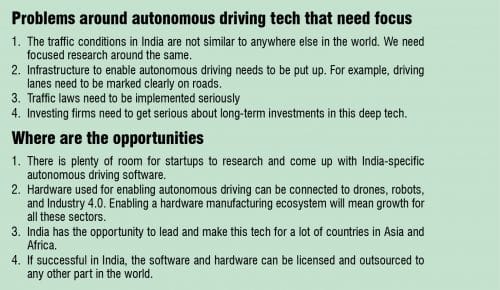Autonomous driving, commonly referred to as self-driving tech, is not a new concept at all. Though it might have started gaining traction in India during the last couple of years, deep tech has been in focus for a lot of companies and institutions for more than two decades now. This is also probably a feature that adds a USP to the vehicles sold by Tesla and other electric vehicle brands all over the world. We at Electronics For You Network got in touch with a man who has dedicated his life to the development of cybernetics and autonomous driving tech.
On the board of various startups into robotics, drones, and self-driving, Dr Rahul Kala is also associated with Indian Institute of Information Technology, Allahabad. He is of the view that conducting research on self-driving tech in India is undertaking research that is not done anywhere else in the world.
In his words, “Autonomous tech is a binary problem and solving 99.9 per cent means that the problem has not been solved.” Here is his take on autonomous tech keeping India in consideration as conveyed to Mukul Yudhveer Singh.

Q. What are your views on the current rate of adoption of autonomous vehicles in India?
A. In terms of the technology as well as the transportation system, we have two quite different India’s. The first one is the national highways that we have and the second one is the city roads where things are extremely chaotic. When you see the first image of India, you can easily relate it to the conditions in Europe and the USA. Lane discipline, people sticking to traffic rules, and a lot of other things resonate between India, Europe, and the USA.
I see a very rapid adoption in the first case as this is where the accidents in India get extremely fatal. Introducing autonomous driving tech in the second India might get extreme as there is generally no lane following discipline there. Motorbikes, three-wheelers, and even pedestrians can pop out in front of vehicles within a matter of milliseconds.
The behaviour of vehicles and people in the second case negates all the principles that automated driving works upon. This negates safe driving principles. Here you will witness close passing and cutting across of vehicles, which by the way is quite a common scenario.
The case two also negates that there is a vehicle that you can follow. Lane keeping is one of the biggest principles of autonomous driving and in case two there exists no such principle in the minds of people in Indian cities.
If you are not talking about lane keeping as an elementary approach of autonomous driving, then you are talking about starting research that is not being pursued anywhere else in the world. Like a city in Prayagraj, where I hail from, will I ever be able to enjoy the comfort of a self-driving vehicle?
To answer your question, I think the bigger adoption will take place in vehicles which mostly ply on national highways and talking about autonomous driving in cities will remain a far-fetched idea.
Q. Talking about autonomous vehicle adoption in India vs Europe and USA, what are your views?
A. I think the difference between India and the USA or Europe at the primary level is, when you are in the latter countries, you are basically looking to eliminate drivers because you are paying them incredibly high salaries. In countries that fall in Europe and in the USA, there are extremely strict rules for commercial drivers. They are entitled to specific amounts of driving every day, and that driving must be accompanied with breaks specified in their laws. These laws make commercial drivers awfully expensive in those countries, whereas no one follows any such rules in India. Commercial drivers keep driving endlessly on the Indian roads.
It is extremely badly regulated in India and the commercial drivers here cost almost a fraction of the cost in Europe and America. In addition, they drive much longer than drivers of these countries. That cost is one that is playing a major factor in differentiating the adoption of autonomous driven tech in such countries.
Q. What about personal cars?
A. The same cost also plays a role in adoption of the tech in terms of driving a personal vehicle in India. For instance, if I get drunk, I can enjoy the privilege of being driven home by a driver at exceptionally low cost. So, why would I want to spend a lot more on autonomous driving tech?
The other thing is that India has never been safety conscious. We are talking about auto driving tech, but can you tell me how many people use helmets on motorbikes and seatbelts in cars? And that is when these are the most basic safety requirements for vehicles plying on Indian roads. Can you also tell me how many people know the safety risks associated with seating six people in a car certified for five people? No one tests vehicles for such scenarios. We, in India, are not safety conscious essentially!
I think that bigger adoption of autonomous tech will come in the commercial sector by the transport companies managing big fleets. For the private sector, the tech might remain a luxury that only the rich would want to test given the road conditions on the streets.
Q. Can the government do something about it?
A. Let me start by saying that owning a basic car, in many parts of India, is still seen as a matter of pride and less of a necessity. Therefore, the complete business model gets into chaos and the government shows less interest because self-driving technology is not a major immediate national problem. In terms of commercial long-haul trucks, there are always at least two drivers on board. In terms of cab driving, the same is becoming an exceptionally large job sector in India. Then a lot of car owners use full-time or part-time drivers for private cars in most of the urban locations.
Autonomous driving tech might cause an immense loss of jobs, and I do not think the government will want to do that. As of now, the scale of benefits is lighter than the scale of losses. It is also not fair to leave everything to the government. The user attitude must be different as well.
The current user attitude in India is not allowing the commercial model of autonomous driving tech to come up in the country. I think the difference in commercial interests is the real problem in India.
Q. The government is trying to increase adoption of EVs, would EVs packed with autonomous driving tech appeal more to people?
A. When you talk about EVs and autonomous driving tech, I agree that it is easier to enable an EV with the tech than enabling an ICE vehicle with auto driving tech, and yes there is more than enough proof that this tech is slowly becoming a USP in electric vehicles.
However, when we talk about the present levels of autonomy in electric vehicles, the advantages of EVs cannot go beyond L1, L2, or at the max L3 level of autonomous driving tech. The question to ask is, does the advantage of EVs matter in terms of L5 level? I do not think it would matter paying a little extra for a little piece of hardware and autonomous driving software when a vehicle already has tens of lakhs (millions of rupees) worth of lidar sensors.
Essentially, that is more than the cost of the vehicle itself, and in the long run the software licenses may cost more than the hardware. I do not think the type of engine, whether petrol or electric, will matter in terms of adoption of autonomous vehicles that offer L5 capabilities.
More importantly, people who go for electric vehicles are more likely to adopt such autonomous features rather than people driving ICE vehicles. I also am of the view that electric vehicle makers will be the first ones to launch autonomous driving features.
Q. Software is seen as one of India’s strengths, is there an opportunity for the hardware sector here?
A. That’s a wonderful question, to be honest. I have a background in robotics and doing robotics in India is a difficult task because that is the juncture where a lot of other technologies in India are struck at. India still lacks in terms of its hardware manufacturing capabilities. Most of the parts including sensors and motors come from Taiwan, China, and other countries.
We need to understand that when Giga Technologies are produced in bulk, they cost only a fraction of what we pay to source these from other countries. Now, because we are mostly dependent on imports for most of the robotic parts, we pay higher because of import duties and a lot of other such things. The problem becomes greater when the parts you ordered start to malfunction, and you do not have a vendor in your own country.
I think the government has done quite a lot and it is now the responsibility of entrepreneurs and industries to do their part as well. A lot of initial steps have been taken, but if you are aiming to make India the hub of autonomous driving hardware manufacturing including the production of lidars, motors, and sensors at established factory lines, then we will have to start by looking at the number of ICE vehicle makers in India, rope them in and their component suppliers as well.
It is a fabulous opportunity; the ministry has said that, the industry has said that, and even the academia has said that too.
Q. Are the perks of setting up such manufacturing big enough to formulate a plan?
A. First, to make such hardware in India, we will have to take aggressive leaps, and the perks of the same go beyond just this industry. We do not talk much about the drone industry, but we should know that the same is very strongly associated with autonomous driving tech. We barely discuss that despite knowing that India needs drones for all its sectors.
Then we have the robotics automation industry, which also resonates with autonomous driving tech. A lot of Indian companies have started using robots imported from the likes of Germany. Once you develop a hardware manufacturing ecosystem you are benefitting the drones, the robotics, and the autonomous driving tech industries. In the larger picture you are creating a growth environment for Industry 4.0 as well.

Q. How, according to you, can these dots be connected to cash-in on the opportunity?
A. The government is already doing a lot on this front. It has set up special economic zones to attract big brands from the world. In fact, it has been done by India at an exceptionally large level already. I think the next important step is to start training people in these fields with special training programs. What this will do is have talent with super-specialised degrees in India. The same will also appeal to foreign companies to set up shop in the country.
Then, of course, there need to be laws introduced that make licensing easy and quick. We should explore ways which can reduce the time between ideation and establishment. There should be a one window solution. But again, a lot of these things have been done already and I seriously have no idea where the industry is getting stuck now!
Q. You have worked on autonomous driving tech in India and in Europe, how far is the adoption in India as per you?
A. When I was working around this tech from 2010 to 2013, we based all our work on the infrastructure that was there in Europe to facilitate autonomous driving. We need to develop that kind of infrastructure to be able to enable adoption of that tech here in India. You cannot even talk about making autonomous tech a reality when you are struggling to make better and safer roads.
These mixed with absence of civilised traffic are the problems that need to be solved immediately. There are people and sectors who will not hesitate in investing into the sector and buy vehicles with such capabilities, but we need to make sure that this tech is safe for India. And as I said earlier, there are use cases in India for which no research is being done anywhere else in the world.
It is also good to admit that L5 is still a distant dream in Europe and USA. L5 is like a binary problem, and even if you solve it 99.9 per cent, you are still left with the problem. The aim in India should be to go after the L3 autonomy. The aim should be to be able to press a button while on a highway and let the tech do all the safe driving for you.
In terms of L3, unfortunately, there is extraordinarily little research being done in India. No vehicle manufacturer is seeing this as a focal point as of now. You will be amazed to know how many modules and other stuff for self-driving tech, to be used in Europe, are being developed in India. Unless the same level of R&D and testing takes place in India, achieving L3 levels will remain a distant dream. This research and testing are a big opportunity for Indian firms.
Q. Talking about opportunities, is there room for startups in the autonomous driving tech arena?
A. There is a big difference between the startup ecosystems of India, Europe, the USA, and the UK. India talks a lot about startups and there are a lot of startups getting registered in India under the Startup India program. The startups are the ones that really dive into the deep technologies space.
However, in countries like the US and the UK you get more access to government and private grants as a startup than you get in India. You also get a lot more investors and help from the academia in those countries as compared to India. This helps startups care more about what they are doing than concentrating on earning bread and butter.

In India, when you are working on a deep tech startup, unfortunately, exceedingly early it goes into the problem of investment. Initial funds given by the government do solve some problems, but they also come with their own set of problems. Unless we can solve the shallow funding problem, we might not see a promising startup in this arena.
Investors need to know that investing in deep-tech companies requires investments for the long run, because when you invest for the long run, the gains are also big!








